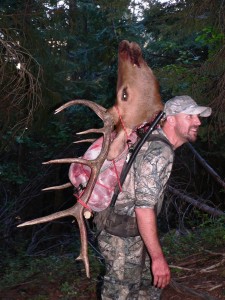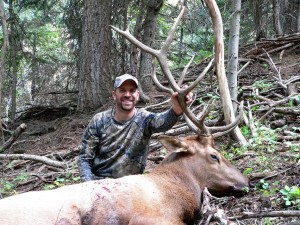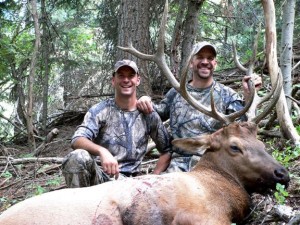17 Years…
Success. It’s something everyone desires to some degree at some time in their life. The very definition of success can vary greatly from one person to the next, however. For one elk hunter, success might simply mean seeing or hearing an elk at some point during their hunt. For another, a hunt might not be deemed a success without harvesting a 400″ bull. That’s what makes hunting special.
For Donnie, successfully harvesting an elk with archery equipment had been something that had eluded his efforts for 17 years. He had many close calls and many successful hunts in those 17 years of archery hunting, but he had yet to attach his elk tag to an elk during archery season.
His best chance had once again come and gone opening morning. With me being the only one with a bugle tube and Donnie being the only one with a release, it would seem the odds were stacked heavily in his favor. Especially given the fact that a bull was bugling 200 yards across the draw from us. Fate had a different ending for that hunt, however.
Two days later, it seems Murphy’s Law was back in effect as a tiny little twig deflected Donnie’s arrow merely inches in front of his bow. His shot drew dirt low and to the left of the nice 6X6 bull standing just 15 yards in front of him. With just 2 days left to hunt before we were set to leave for Arizona, it seemed time and luck were running out.
We left work early on Thursday afternoon and drove the 2 1/2 hours to our hunting area. Scrambling up the steep mountainside, we knew the odds were against us. I also reflected on a comment the great Babe Ruth once made…
One season, during a post-game interview after the Yankees had clinched the American League pennant, the Babe was asked, “What do you do when you get in a batting slump?”
His reply: “I just keep goin’ up there and keep swingin’. I know the old law of averages will hold good for me the same as it does for anybody else, if I keep havin’ my healthy swings. If I strike out two or three times in a game, or fail to get a hit for a week, why should I worry? Let the pitchers worry; they’re the guys who’re gonna have to pay for it later on.”
With time running out and our backs against the wall, this was the attitude we took. I have to be honest though. As we stumbled out of the mountains in the dark that night, having heard not a single elk, I was a little worried.
The next morning we tried a different drainage, and it was just what we needed! In the 9th inning we had found a good herd of elk. The bugling action that morning was some of the best we’d had all season. We called a small 6X6 in to our first set-up but he circled us and caught wind before he came in to shooting range.
We worked in on the next bull and soon found ourselves 20 yards from a big 6X6 bull. Just as we slipped over the ridge to get a good look, and hopefully a shot, at him he walked off heading up the ridge to his bedding area. He crossed in front of us at 35 yards but didn’t offer Donnie a good, clear shot. We chased a couple more bugles that morning, energized by our good fortune and encouraged by the action.
That evening our luck seemed to be continuing and we were into bugling bulls as soon as we climbed over the first ridge. With Donnie set up 50 yards out in front of me, and a bugling bull thrashing a small pine tree 70 yards on the other side of him, our confidence was brimming. As the big bull turned and started towards my calls, my mind was on skinning and quartering, and I could already see Donnie standing behind the bull, smiling a smile that had been penned up for 17 years waiting for this moment.
All at once the bull whirled and crashed up the hillside where he began barking alarm bark after alarm bark for 15 minutes. The wind was still perfect…I had no idea what had blown the set-up. Donnie finally snuck back down the ridge to me and told me about the black bear that had been working its way down the ridge towards our calls and met up face-to-face with the big bull. The bulls reaction was warranted, but it didn’t do anything to help us with our situation. As darkness fell on the dawn of our final 24 hours of Idaho elk season, our optimism was beginning to give way to doubt.
Daylight brought echoes from my bugle tube in the drainage that had been ringing with elk bugles the day before. Our 3 hour hike didn’t stir up a single bugle and we returned to the truck severely deflated. We’d given it all we could and we’d had some close calls. It was a successful hunt, although a set of antlers and a pile of game bags in the back of the truck would have given the drive back home more of a successful feeling.
We took down camp and loaded our gear into the truck. It was 12:30PM and we made a plan to drive out to the main road, take a nap, then give it one last try in a new area. We drove 4-5 miles on the logging road and pulled over to grab a water and some food from the cooler for lunch. The warm afternoon sun was making it difficult to keep my eyes open, so I grabbed my bugle tube and told Donnie to grab his bow. We walked down the ridge from the truck to a vantage point overlooking the canyon below, hoping we might be able to arouse a napping bull elk.
The fact that we hadn’t grabbed flashlights, game bags, water, or even a knife, was far from our minds when a bull answered our first bugle 2 or 3 ridges away. A quick check of the wind currents confirmed the afternoon sun was doing its job pulling the air up the hill, so we immediately dropped into the canyon to close the distance. We dropped down to a point that put us directly across from where we thought the bull should be and set-up. I let out a soft cow call and was immediately answered by the bull. Before he was able to finish his bugle, I cut him off with as much excitement and aggression as I could muster.
The breaking branches and sound of antlers brushing through the thick alders told the story. This bull was not keen on our presence and he was on his way to do something about it. He hit the draw and everything went silent. I was sure he was sneaking in, likely trying to get above us and get the wind in his favor, so I slipped down the ridge 60 yards and left Donnie on the trail leading down the draw. My cow calls and bugles were met with silence, however. I went to work raking a tree, confident that would pull him up to Donnie. After 10-15 minutes of silence, he bugled back to us from his original bed on the opposite ridge.
We slowly dropped into the draw and quickly saw why he had given up. The creek bottom had washed out in the high spring run-off, leaving a tangle of alders covering a 10 foot drop off into the ravine below. After fighting our way through the obstacle course we emerged ready for Round 2. The bull, however, decided he wanted to be left alone and silently moved off down the canyon. We stood in his bed and bugled a challenge to him. The result was unexpected, but equally welcomed. Another bull answered from the backside of the next ridge.
We once again laid out our approach and began our silent descent into the draw below us. As we started up the opposite hillside, we realized we weren’t going to be going any farther quietly. Dried ferns and buck brush made it impossible to mask our sounds, so we were down to one last option. Bugle and run through the brush like a herd of elk. As we topped out on the ridge the hillside erupted with elk. Cows scattered below us and the herd bull screamed from above us on the ridge. We were in the perfect position.
I gave an aggressive bugle right back to make the bull think I had moved in and was rounding up his cows and the plan worked to perfection. Right up to the point where the big bull stopped behind a thick fir tree which offered Donnie no shot. At 35 yards we could only watch as the bull continued on down the draw to catch up with his harem.
It was 3PM and we were acutely aware of our chances of getting in on another bull that afternoon. We sat there on the edge of a small bench, responding with bugles to the calls coming from the herd that was now making its way directly away from us. Suddenly, a branch broke 50 yards below us on the hillside, followed by silence. We stood there, offering a couple soft cow calls to whatever might be walking below us. After a minute or so I could see antler tips coming up the trail 30 yards below us. At 18 yards, a nice 6X6 bull stopped and looked up the hill in our direction. With trees covering his vitals our only option was to remain frozen. After 15-20 seconds, the bull continued up the trail and a cow call stopped him at 15 yards, completely broadside to Donnie’s full-drawn bow.
At the shot, the bull whirled and crashed down the hill. Then silence. Donnie turned towards me and, yanking to free his hand from the wrist strap on the bow, began making a low, growling sound which quickly turned into a high-pitched whine. I had heard that sound a year before when Donnie’s bowstring hit his forearm on an antelope hunt. I worried his shot might not have found its mark.
With his hand finally free from the bow, Donnie turned and raised his hand to give me a high-five, and the sound he was making spilled out into an elated victory whoop. 17 years of bowhunting excitement, close calls, education, and frustration, came spilling out of the most contagiously excited, successful elk hunter I have ever hunted with.
Donnie hurdled boulders and blown-down timber on the way back to the truck to grab our packframes, knives, flashlights, and water. I’d say he was still hurdling them 2 trips later with the last of the elk on his back, but I’d be lying. His smile, however, was still just as wide.
Congrats Donnie!



